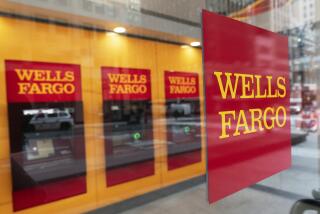Fed officials were split over discount rate cut
- Share via
Half of the 12 regional Federal Reserve Banks opposed the central bank’s decision last month to lower by a quarter of a point the rate paid by banks on loans from the Fed.
In the days before the Federal Open Market Committee’s Oct. 30-31 meeting, directors of the Fed banks of Boston, Cleveland, Dallas, Kansas City, Minneapolis and Philadelphia voted to keep the discount rate unchanged, according to minutes, released Tuesday, of meetings from Oct. 1 to Oct. 31 of the Federal Reserve Board, which sets the rate. The New York Fed, which earlier in the month had said it wanted to hold the rate steady, subsequently switched its vote to favor a quarter-point reduction.
The account released Tuesday confirms a difference of views at the central bank last month about the need for lower borrowing costs after the open-market committee reduced the federal funds rate, the Fed’s key short-term rate, by half a point Sept. 18. Minutes of last month’s open-market committee meeting, released last week, say the decision to cut the benchmark rate further was a “close call.”
According to the board minutes, “Directors in favor of maintaining the current [discount] rate also noted that downside risks to the real economy remained, notably in the housing sector. However, they assessed incoming economic data overall as positive and financial markets as gradually improving.”
The open-market committee voted Oct. 31 to lower its target for the federal funds rate, the rate paid by banks to borrow money overnight from other banks, to 4.5% from 4.75%, citing concern that the housing downturn would drag down the broader economy. The board pared the discount rate by a quarter of a point to 5% after considering requests to do so by six district bank boards.
The regional Fed banks that called for the cut in the discount rate “considered a further easing now to be an appropriately preemptive approach to downside risks to economic growth,” the minutes recount.
Kansas City Fed President Thomas M. Hoenig was the lone opponent to the cut in the federal funds rate.
Presidents of at least three banks had expressed skepticism about the need for more cuts and optimism about the resilience of credit markets.
“My view is that we should go cautiously,” Hoenig said Nov. 15, citing risks from slowing growth and accelerating inflation.
On Tuesday, Philadelphia Fed President Charles I. Plosser said last month’s cut in the benchmark rate might have raised inflation risks and might need to be reversed if consumer prices climbed.
“If inflation begins to creep up or expectations of future inflation rise in the coming months . . . the outlook will be affected and policy may have to be adjusted,” Plosser said in a speech in Rochester, N.Y.
More to Read
Inside the business of entertainment
The Wide Shot brings you news, analysis and insights on everything from streaming wars to production — and what it all means for the future.
You may occasionally receive promotional content from the Los Angeles Times.










